How to write sales proposal that converts? (with templates)
Eye-grabby intro with a made-up number highlighting why sales proposals are ever-so-important in the ever-changing landscape of something*
Well, pardon us as we lean into this trope too.
In any case, if you’re here, you’re probably looking for ideas on how to create sales proposals.
Or you had a prospect that said, “can you email me your proposal” after multiple cold emails and you wanted a quick, easy template to get started.
Please feel free to use the index to jump to parts that you find relevant.
And if you’re here to just educate yourself about sales proposals, we’ve got just the thing for you.
What is a sales proposal?
A sales proposal is a document sent to buyers to help secure sales deals. These work as information brochures containing solutions, offerings, and pricing plans. It's a key part of many business sales cycles.
It's known by various names in different circles - you might hear it referred to as a "business proposal" or a "product proposal," but fundamentally, they all serve the same purpose.
Where is it used?
Typically, these proposals come into play during the middle or end stages of the sales pipeline - or atleast once the prospects have made their requirements known. Allowing for the seller to present more personalised solutions and offerings.
Why is it used?
An effective sales proposal is a showcase of why a prospect should choose to engage with your company.
It's about clearly understanding their specific needs and challenges while presenting a solution your company is uniquely positioned to provide.
The goal is to communicate readiness and capability to address the challenges.
However, it's important to note what a sales proposal is not. It's not a deep dive into every detail of your products or services. While this information is important throughout the sales journey, it's not the core of the proposal.
The proposal's primary objective is to establish trust and confidence in your company.
Once this foundation is laid and the prospect feels comfortable, you can then introduce more detailed information about your products, guiding them further down the sales pipeline.
What does a ‘great’ sales proposal contain?
| An effective sales proposal contains | What does it mean |
|---|---|
| Crisp, concise information | Every line on the sales proposal should add value to the document, and the deal. Meaning no jargons, fluff and unrefined content. (much like this blog :P) |
| Every claim backed with evidence | All the information on your sales proposal needs to be backed by credible stats, testimonials or case studies. |
| An end-to-end response for every problem at hand | Make sure to grasp your prospects’ requirements fully and provide holistic solutions. |
| Clear-cut pricing plans | Most organisations give personalised pricing plans for each prospect. This usually shows effort in working with them as your customers. |
| Content supplemented with visuals | A sales proposal should never just be text. Always supplement text with relevant media to help people skim through content easily. |
Why do you need sales proposals?
A sales proposal is what you leave your prospects with after a demo. It’s a representation of your company, your products/offerings and your brand.
And if that’s the medium you’re using to convey your brand’s message, wouldn’t you want it to be memorable?
Here’s why you’d use sales proposals:
It lays out precisely what you're offering, leaving no room for misunderstanding or interpretation. This clarity helps the potential client know exactly what they can expect from your product or service.
A sales proposal can be tailored to address the client's specific needs and pain points. This personalised approach demonstrates that you've done your homework and are committed to providing a solution that fits their unique situation.
A strong sales proposal can set you apart from the competition in a market where clients might be considering multiple vendors. It's an opportunity to highlight your unique selling points and why your offering is the best choice.
Who writes sales proposals?
The process of creating a one of these requires a deep understanding of your offerings, what the requirements of your prospects are, how your offerings can solve these requirements, and the knowledge of how your competitors can go about things - and that’s just the “need to know”s.
Daunting? Maybe. Doable? Absolutely.
This is where teamwork comes in clutch to make sure you deliver the best proposal you can.
It’s usually a collaborative effort by people who know know what your organisation offers, hand in hand with industry experts - with content specialists translating this information into words that are easy to understand.
The people who take up proposal responsibilities usually include:
- Proposal Specialists
- Bid Managers
- Product Marketers
- Pre-sales Analysts
- Sales reps
- Business Development Reps
- CxOs
The creation of sales proposals usually varies depending on the industry and scale of the deal. Some factors that usually determine the compositions are:
Complexity of the Product/Service: Industries with highly technical or specialized products (like aerospace, engineering, or IT) often require the input of technical experts, whereas industries with more straightforward offerings (like retail or basic services) might rely solely on the sales team.
Size of the Company: Smaller companies might have a 'wear many hats' approach where sales, marketing, and even leadership contribute to proposal writing. Larger companies are more likely to have specialised roles or departments for this task.
Type of Client: B2B (business-to-business) proposals often require more detail and technical information compared to B2C (Business-to-consumer) proposals, which might be shorter and more focused on benefits and pricing.
Regulatory Environment: Industries with heavy regulation (like pharmaceuticals, healthcare, or finance) might require more involvement from legal and compliance teams to ensure that the proposal meets all regulatory requirements.
Sales Cycle Length: Industries with longer sales cycles (like real estate or industrial machinery) may require more detailed and evolving proposals, while those with shorter cycles (like retail products) might use more standardised, brief proposals.
What are some fundamentals when it comes to building your Sales Proposal?
Before we actually get into building it, here are some fundamentals to keep in mind - with some inspiration from April Dunford (we’re big fans!).
1. Understand your audience and their requirements.
Make sure they know that, too, with how well you explain their issues and your plans to address them.
2. Positioning is key.
Position yourself to stand out from your competitors by solving the prospects' requirements. Provide very specific solutions to each of their needs - and tell them what they’ll miss out on with your competitors.
3. Tell a story with your sales proposal.
Present the challenge, showcase the solutions, and back those solutions up with examples (like case studies, testimonials, etc.) - this helps you build a narrative and make a more compelling case (that’s also easier to read).
4. Avoid jargon and complex language.
Use clear, concise language that doesn’t require them to use the dictionary to understand your words.
5. Be flexible with your proposal.
Your sales proposal shouldn’t have a “one size fits all” approach - rather, it can’t. Tailor it according to each prospect, industry, size, and unique requirements. This showcases the extra effort that you’ve put into making the sales proposal.
Have an existing sales proposal? Use the engagements as insights.
See how your previous sales proposals have worked for you. If a certain template or approach shows success (more on this later) - make use of it. If a certain approach doesn’t seem to work, phase it out.
Iterate, Iterate, Iterate.
Standing out in a crowded B2B Sales Environment
Everybody whips out a sales proposal for deals in their pipeline. Sometimes a prospect may receive multiple proposals from multiple vendors. This is where you need to stand out.
This little extra mile can go quite the distance in presenting yourself as the best possible solution for your prospect to go with. What is the extra mile you need to go?
1. A researched understanding of the client’s needs
Do some research into the client’s specific industry and their individual needs before presenting solutions.
2. Evidence and social proofs
Include data, case studies, testimonials, or third-party validations that provide evidence of the success of your products or services. This builds credibility and trust.
3. Competitive differentiation
Clearly articulate what sets your offering apart from competitors. This could be unique features, superior service, better pricing, or any other factor that gives you an edge.
4. Creating interactive sales proposals
Interactive sales proposals surpass PowerPoint presentations by offering a more engaging, personalised experience.
With seamless multimedia integrations, higher engagement rates and responsiveness across devices, they provide much better reading experiences.
They help you measure the success of your sales proposals by providing real-time insights on how prospects are consuming them with analytics such as (Time spent, Percentage completed, heatmaps, etc.)
To Make Content That is Bingeable and Not Boring
Let’s dive a bit deeper into this.
Why do the traditional documents (like PPTs, Word Docs and PDFs) not cut it anymore?
Static formats of documentation are being sunsetted across industries.
Using interactive content platforms like Cleverstory, as opposed to traditional methods, can make your sales proposals more effective for several reasons:
1. Engagement and Interactivity:
Interactive content, by its nature, is more engaging than static documentation. It encourages active participation from the user, making the experience more memorable and impactful. Static formats, in contrast, are often passive and can struggle to maintain user attention.
2. Data Collection and Analytics:
Interactive content allows for the collection of data on user interactions, which can provide valuable insights into user behaviour and preferences. This data-driven approach is not possible with static formats.
3. Complex Information Presentation:
Interactive formats are better at simplifying and presenting complex information. They can use elements like interactive graphs, videos, and animations to explain concepts that might be dense or overwhelming in a static document.
How do interactive content creation platforms help you build sales proposals?
Sales proposals are meant to convince the buyer that you’re the right fit. This is usually helped by the document being narrative-led and interactive - leading to buyers retaining your messages better.
51% of B2B buyers say their content being interactive is helpful when tackling business decisions - such as reading a sales proposal.
That’s where Interactive content creation platforms like Cleverstory step in, enabling the creation of persuasive and highly effective Sales Proposals for multiple brands across multiple industries.
How do you build an effective sales proposal? - A Step by Step guide.
If you’re building a proposal for the first time, all that pressure to put your messages across in the best possible way might sound daunting - don’t worry, we’ve got you covered.
Here’s a step-by-step breakdown of how organisations build effective sales proposals.
Step 1: Cover Page and Index
Step 2: Executive Summary
Step 3: Understanding Client’s requirements
Step 4: Presenting the Solution
Step 5: Pricing Page
Step 6: Expected outcomes
Step 7: Terms and Conditions
Step 1: Cover page and index
Cover Page
It has to be representative of your brand, and relevant to what is being spoken about within the document. Remember, this is your document's first impression, and it sets the tone for the rest of the reading experience.
To get started, Cleverstory has templates you can use to plug your content and numbers in to make things a lot easier.
It’s not just the content you can edit either; you can tailor your brand colours to make sure you follow your guidelines to a T.
Index
A sales proposal's average length can range from 15 to 60 pages - which can get taxing to read. Hence, the importance of the index.
Every stakeholder can get the information they want without having to rummage through the entire document.
One of the best ways to present indexes to readers is using interactive hotspots.
Cleverstory’s hotspots allow for a short description of what each pointer covers to be available to the viewer on hovering over the title.
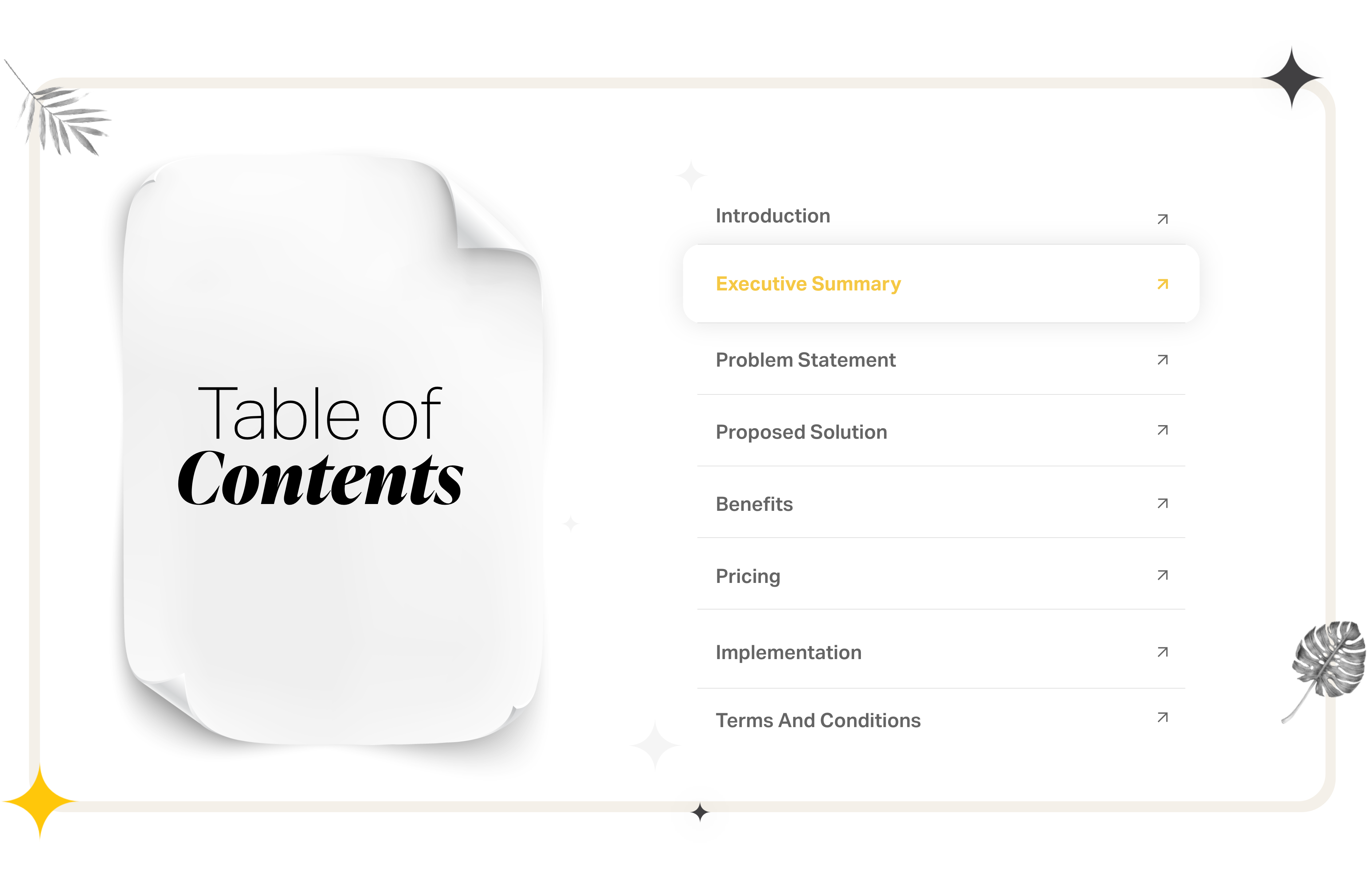
Step 2: Executive summary
Keep in mind that only 27% of sales proposals are read entirely.
Why?
Because buyers tend to skim through the summary and head straight to the pricing page.
And if your summary doesn’t do justice to the rest of the document, you can consider the effort put in to be null and void.
To make sure that isn’t the case, ensure this section serves as a consolidation of all the important information that the document covers. It must act as a “sneak peek” of sorts into what’s in store, and nothing more.
Give too much information, and they won’t read the rest of it.
Give too little, and they won’t be interested.
It’s a fine line - but one that can be tread a lot easier with interactive content.
A way to translate interest in your summary to the rest of your proposal is by using features such as Cleverstory’s Anchor.
The anchor feature can lead the reader to whichever page they’re interested in right from the summary. This ensures the readers get access to information they’re interested in right when they’re consuming your content.
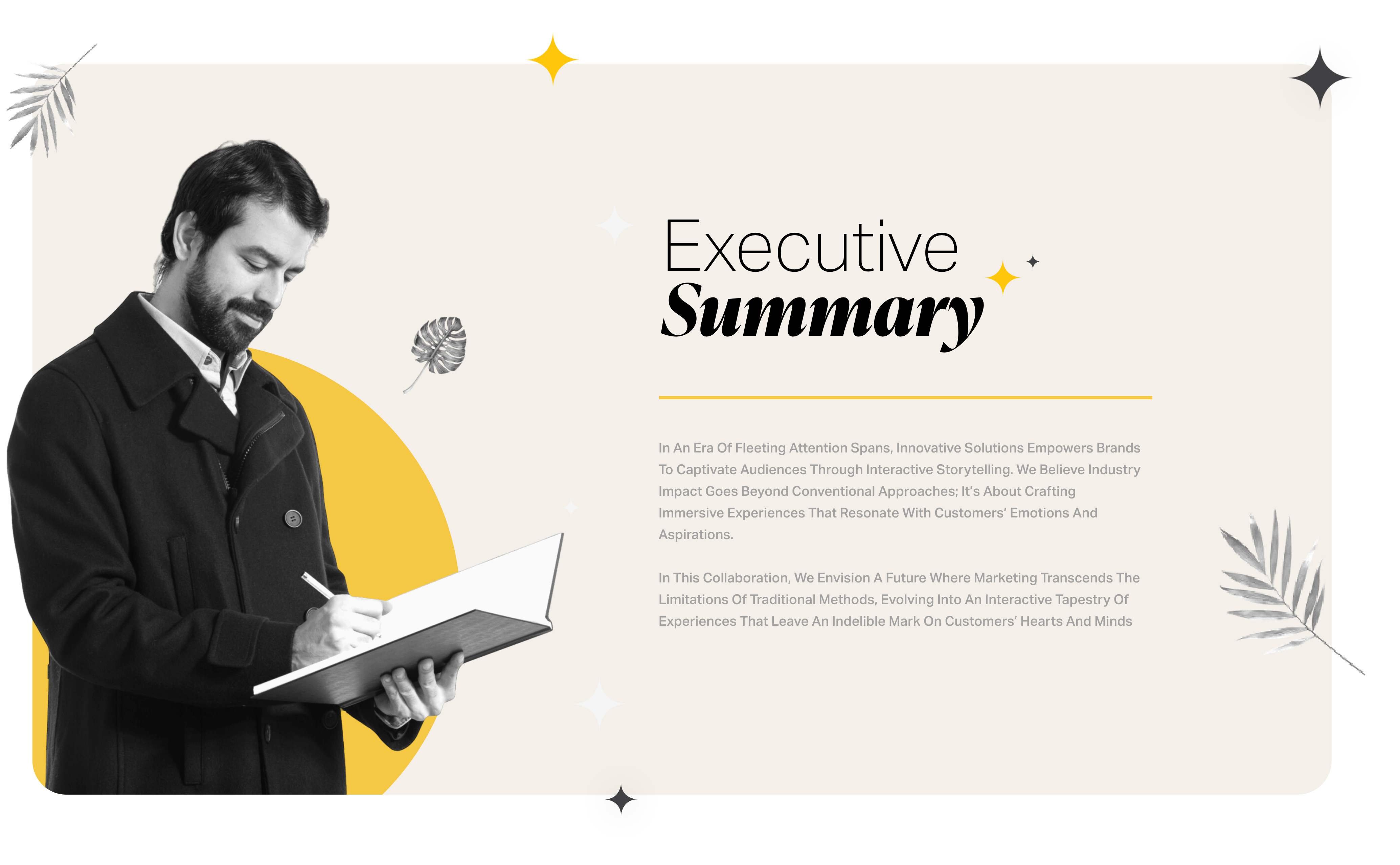
Step 3: Understanding the client’s problems
Understanding the requirements posed by clients is of paramount importance in delivering the right sales proposals.
Make it known that you fully empathise with them on their issues and that most, if not all, of them can be solved by your product or service.
Break down their problems into pain points that your offerings can tackle individually. Bring in context from prior conversations (if any) that you’ve had with this specific prospect.
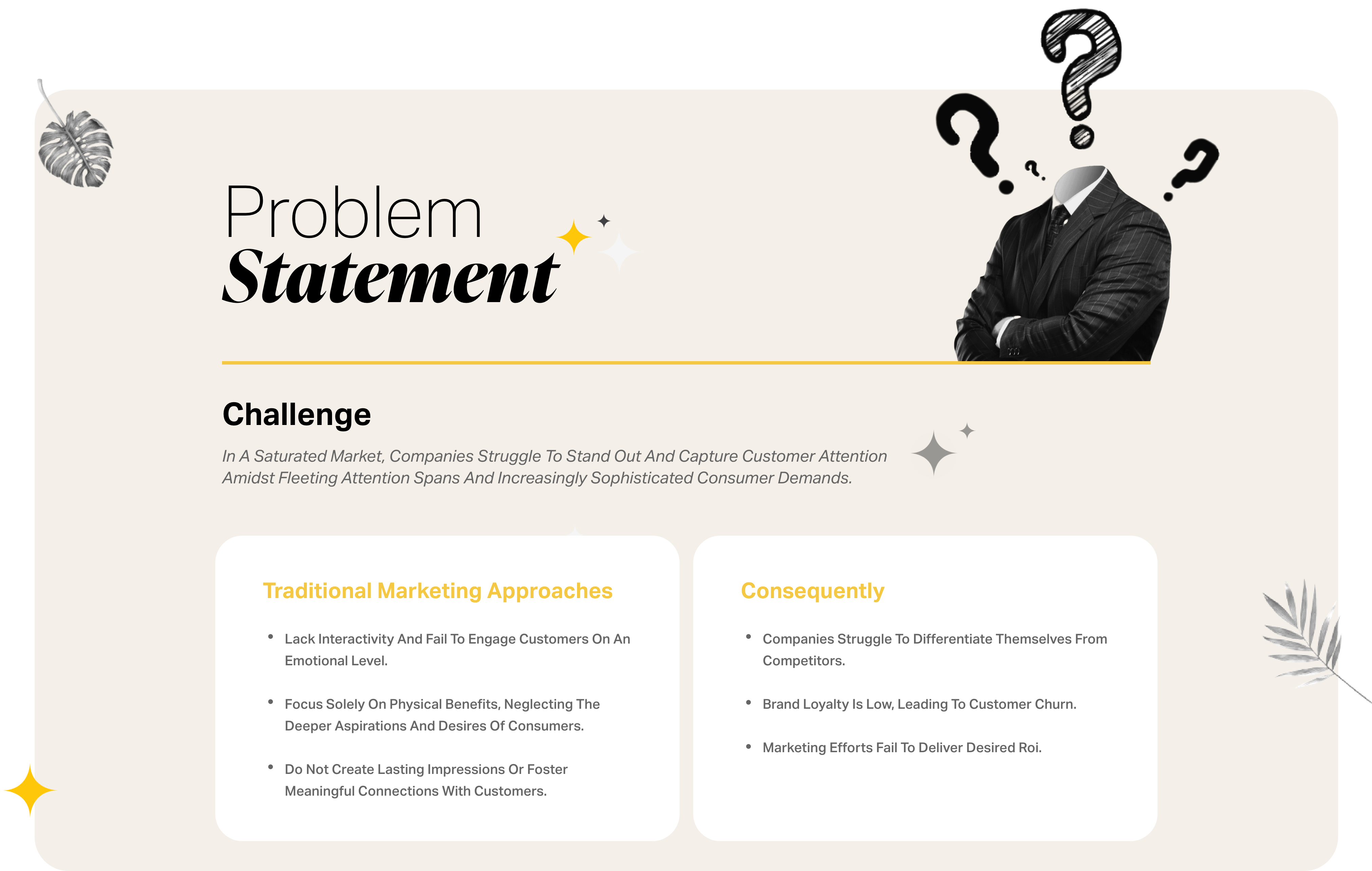
Step 4: Presenting the solution
Now comes the part your readers have been waiting for.
For many clients, the value proposition is the core factor in their decision-making process. It succinctly answers the critical question, "Why should we choose this product/service?"
When presenting the solutions, ensure that every solution is concisely explained and supported with relevant documentation and data.
A detailed solutions section allows you to tailor your offering to the client's unique needs. This customisation shows that you're not just offering a generic product but a solution tailored to make their lives easier.
This should provide the necessary information for decision-makers to understand the benefits and outcomes that can be expected by choosing your team. In B2B sales where multiple stakeholders are involved, the need to divulge these pointers well becomes priority number one.
Cleverstory takes this a step further by allowing users to embed documents into the proposal to ensure readers can absorb the maximum amount of information with minimal effort.
This ensures that your value propositions are read and understood - not just skimmed through (due to the constraints of static content).
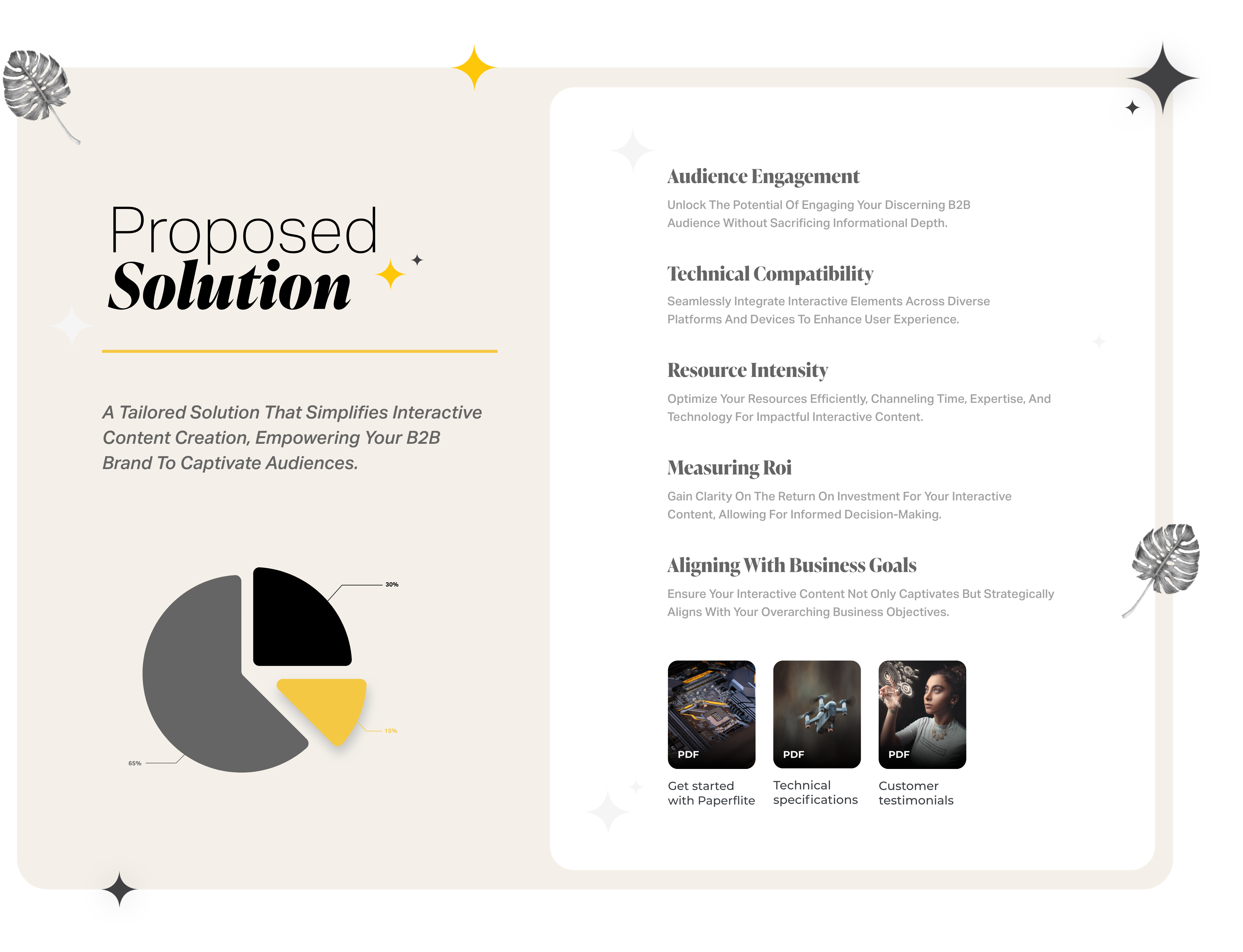
Step 5: Pricing page
When talking dollars, it’s important to provide them with more than one pricing plan.
This helps on multiple fronts, such as:
- Catering to diverse budgets and making your product more accessible to customers.
- Allowing for flexibility and customisation. This gives them the choice of choosing a plan that aligns with their need the best.
- Providing you with a competitive advantage where your offering is seen ready to cater to diverse needs and challenges instead of a rigid mode of operation where you don’t make changes to accommodate different requirements.
- Acting as risk mitigation for customers. The lower-priced or basic plans can serve as entry points for customers who are hesitant or risk-averse.
Cleverstory customers have the perks of utilising interactive comparison tables and CTAs. This simplifies buyer decision-making with the help of vivid user experiences.
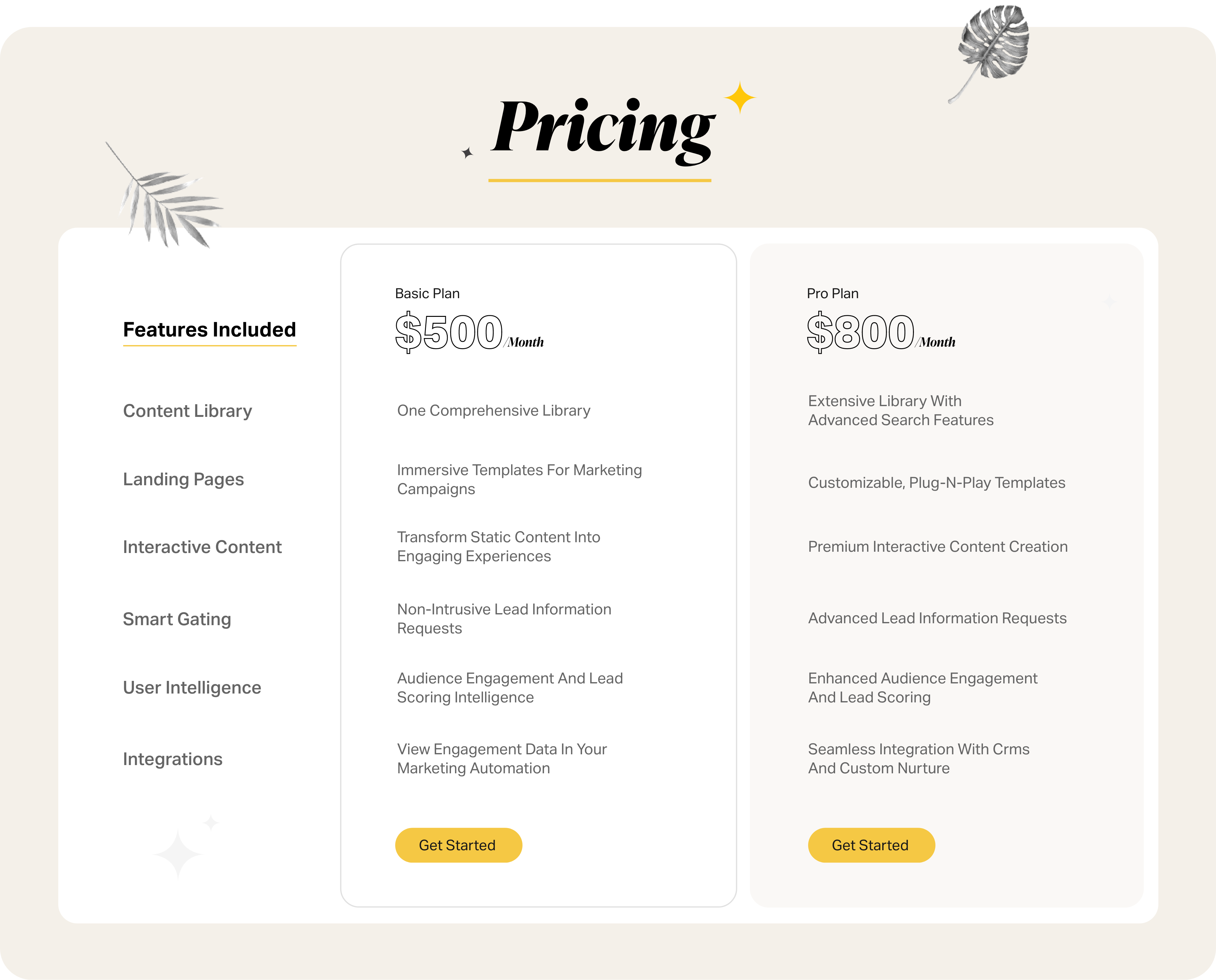
Step 6: Outcomes page
The outcomes page acts as your section to back your claims with some credibility.
This can be achieved by sharing the experiences and success stories that other customers (preferably those with similar requirements or within the same industry) have experienced with the help of your offerings.
You can go a step further and add some testimonials by users from those companies which can then be embedded into the proposal using Cleverstory. This provides a quick peek into what life looks like before and after your product/service to the prospect who’s reading the proposal.
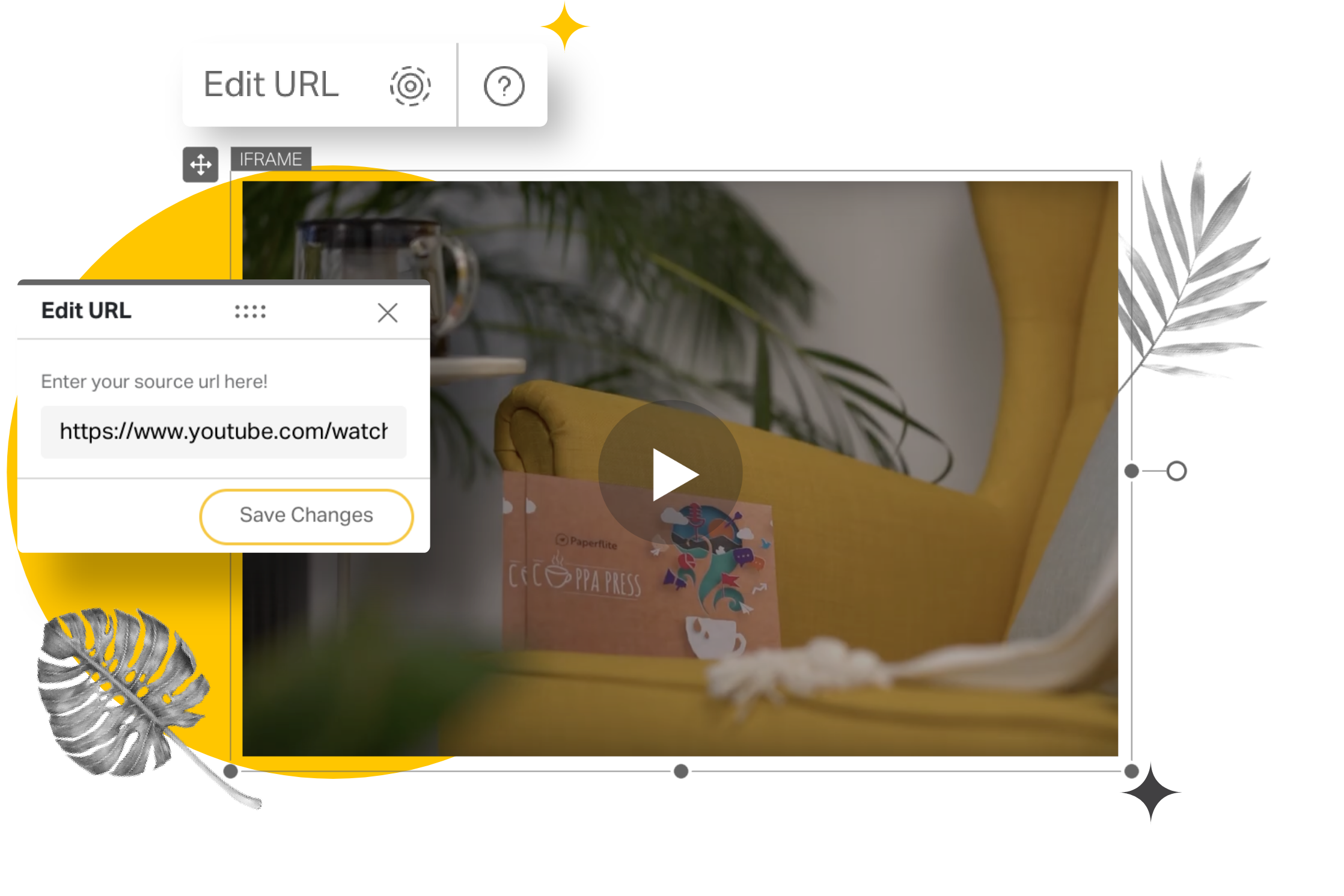
Importantly, include data-driven insights. Talk about impacts such as
- RoI your customers have enjoyed after buying in
- The time it took to implement your offering
- Good adoption rates across your customers’ teams
- Reduction in process times
- Industry-standard metric comparisons for the above
These can lead to an increase in confidence from your customers’ side about choosing you.
Step 7: Terms and conditions
Though you are presenting a solution that’s flexible and personalised to the prospective customer, this section should set firm boundaries on what the expectations of the partnership should be.
Things to keep in mind
Everyone can create proposals - but 44% of sales reps admitted needing more training on writing effective sales proposals.
Once again, we’ve got you covered with pointers to keep in mind while presenting your proposal.
Clarity of your Proposal
Every proposal you create needs to be concise. Readers will sniff out any kind of fluff or forced flavour, and it won’t do a world of good for your deal.
Make sure to address the four important pillars of your proposal: understanding the problem, providing the solution, outlining expected outcomes, and aligning on the budget.
Check for content redundancies and language inconsistencies throughout your document - this uniformity and attention to detail can go a long way to establishing your organisation as a serious contender that your prospect needs to consider.
Templatising Proposals that work
Templatizing successful sales proposals can be highly beneficial, and while not strictly necessary, it offers several advantages that can streamline the sales process and improve the overall quality of future proposals.
This ensures consistency in the way you present your offerings, allows for quick plug and play workflows, and allows for a way to measure which sales strategy works best for your teams.
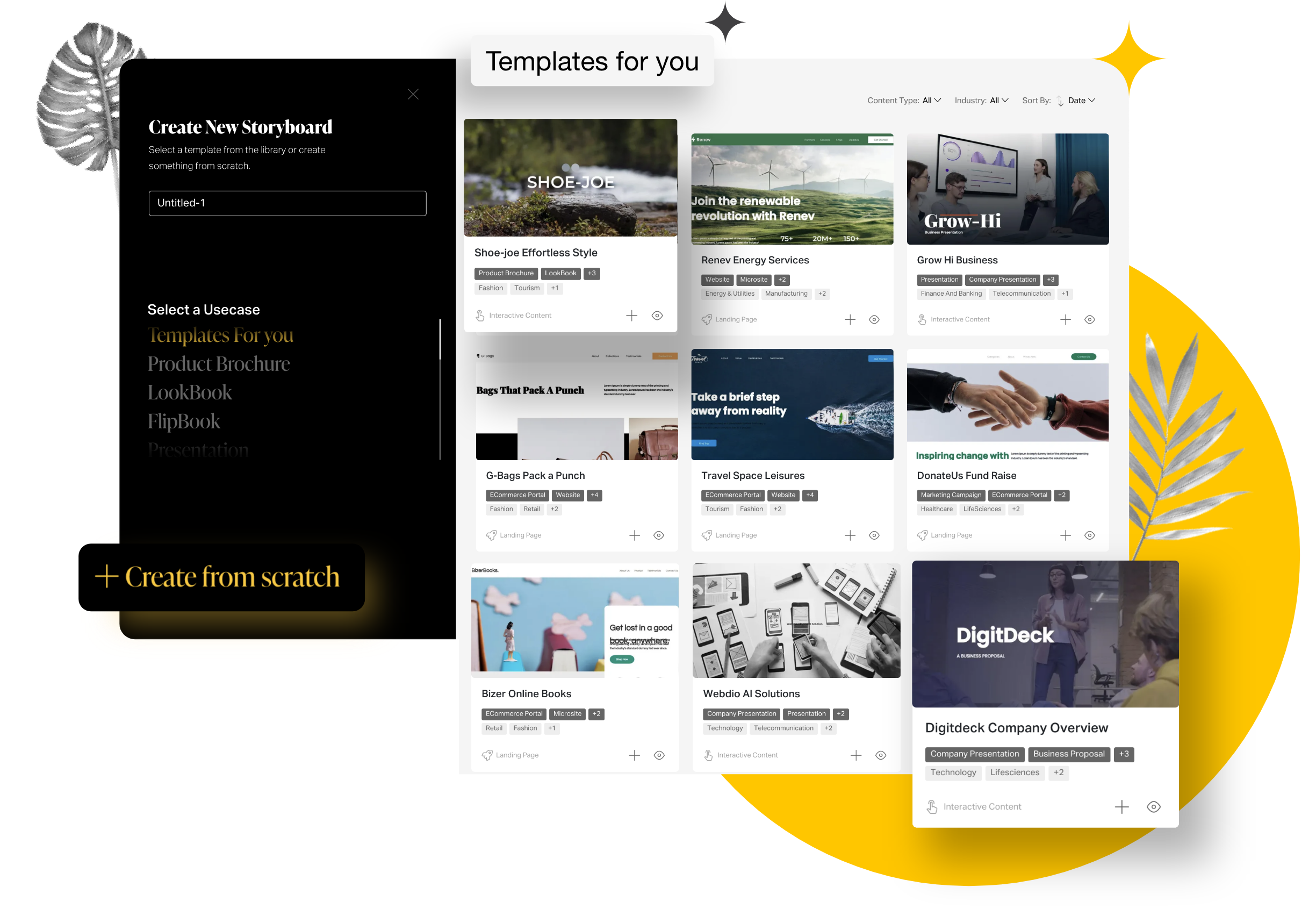
Insights of sales Proposals
One of the biggest advantages of using interactive content to build proposals is the ability to derive insights from the way readers engage with your content.
The analytics on platforms like Cleverstory present the number of sessions and visitors, the average time spent on your documents, which pages drew the most attention, which buttons got the most clicks and other data such as number of opens, shares, downloads etc.
Cleverstory integrates with platforms such as CRMs (Like Salesforce, Hubspot and MS Dynamics) and MAPs (like Hubspot, Pardot and Marketo) to help track engagements and tailor follow-ups accordingly.
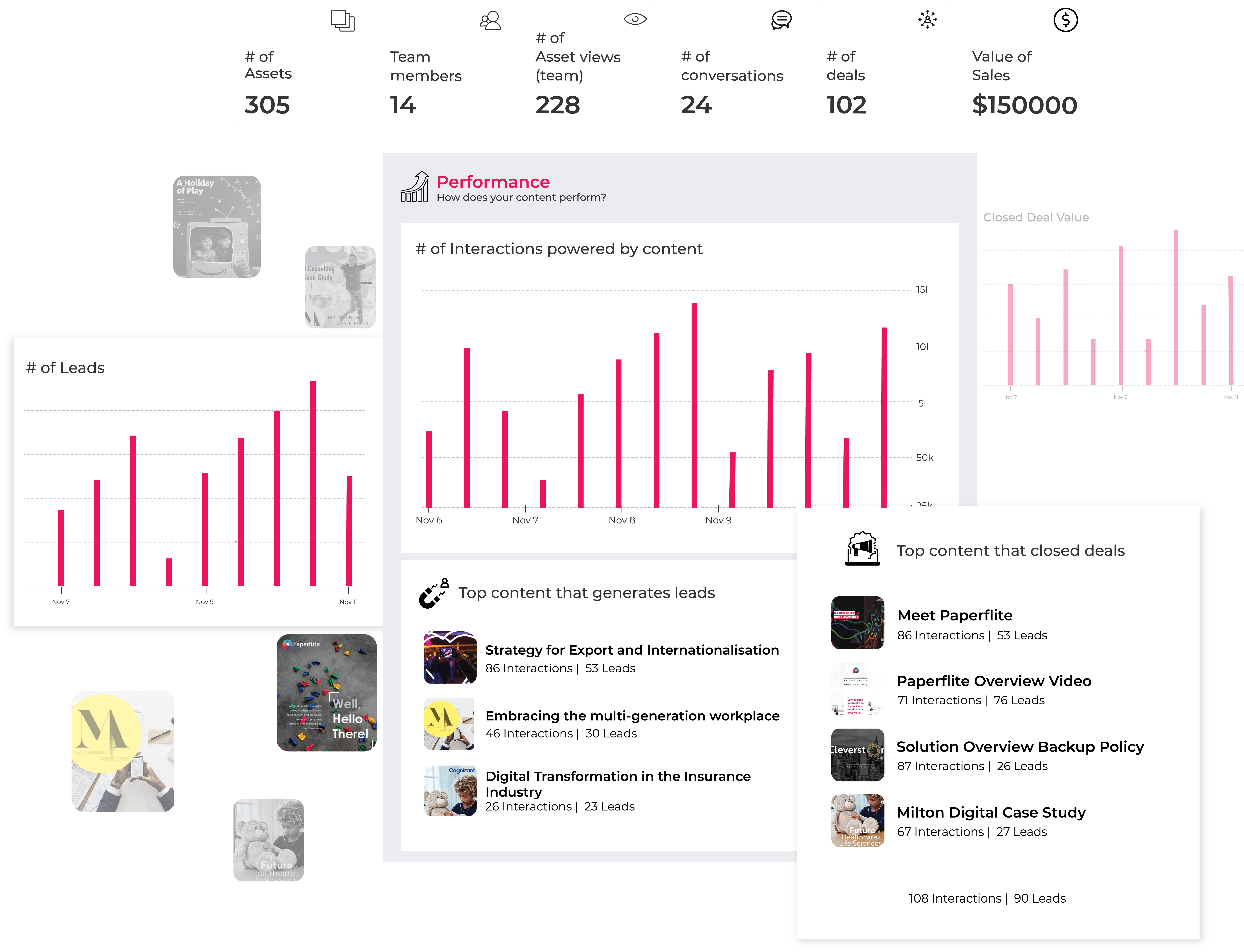
Why are these important?
- To make sure that your documents are being read
- To see what approaches work well with your customers and tailor your proposal strategies and templates accordingly.
Keeping your Proposals secure
A lot of corporate data is under NDAs and password protection, your sales proposals deserve the same security.
The data exchanged is confidential, and deals are not for public viewing, so keeping the sales proposals under wraps might just become paramount as the number of proposals and prospects you work with increases.
Cleverstory users get password protection and NDA sign requirements as built-in features when creating a document.
Needless to say, they’re some of the most commonly used features used when creating deal documentation.
Adaptability and device responsiveness
The number of views on formal documentation through mobile devices has shot up significantly of late.
That’s why ensuring multi-device adaptable design is growing in importance within the business landscape.
Responsive design (like on Cleverstory) automatically detects the device on which your page is being viewed and renders it according to the dimensions it has to work with.
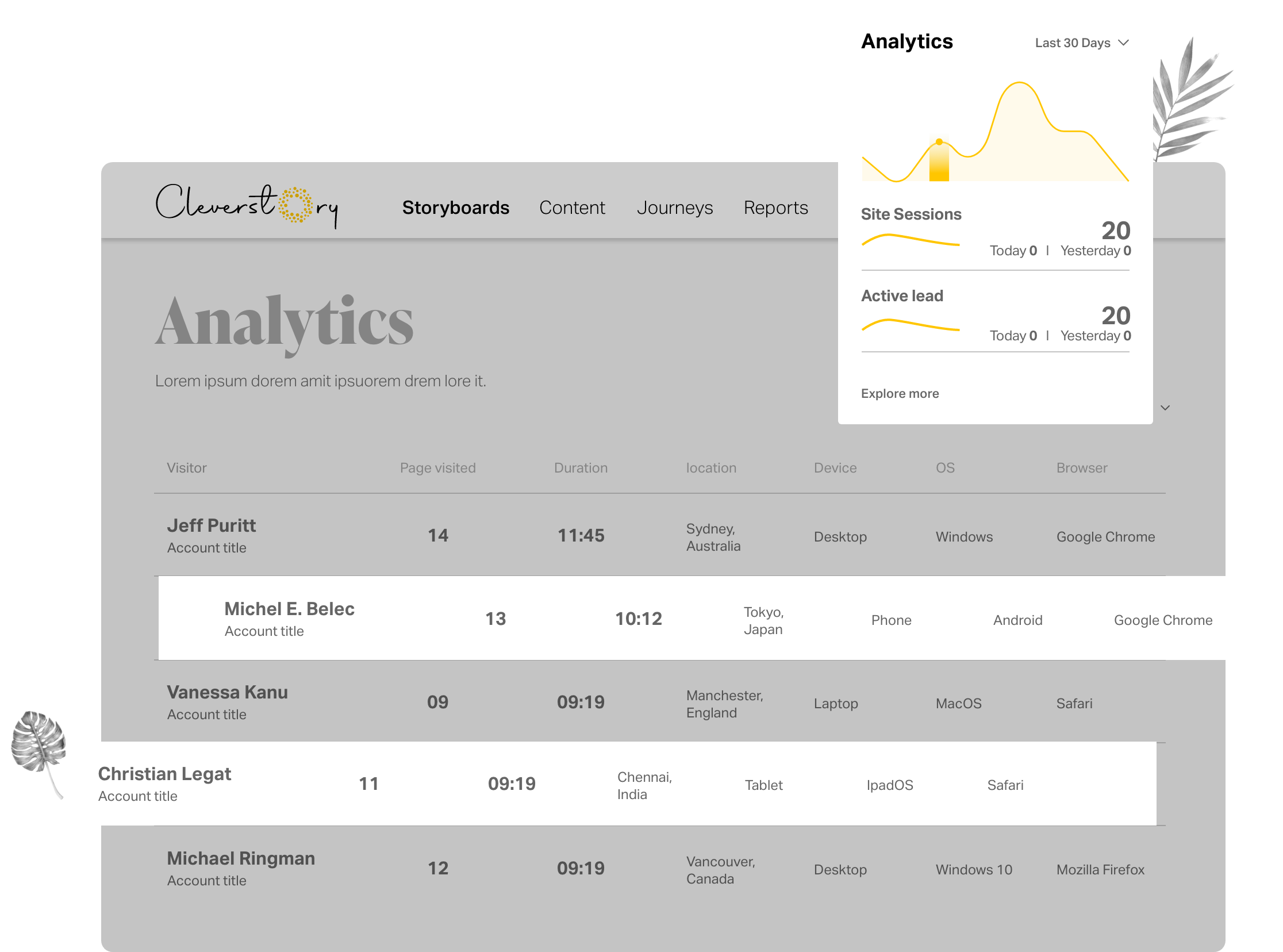
Sales Proposal Template
In the link below you’ll find a handy repository filled with Sales Proposal templates that you can derive inspiration from when creating your own!
Best part? If you’ve already got your sales proposal templates as a ppt, Cleverstory can make it interactive in a single click!
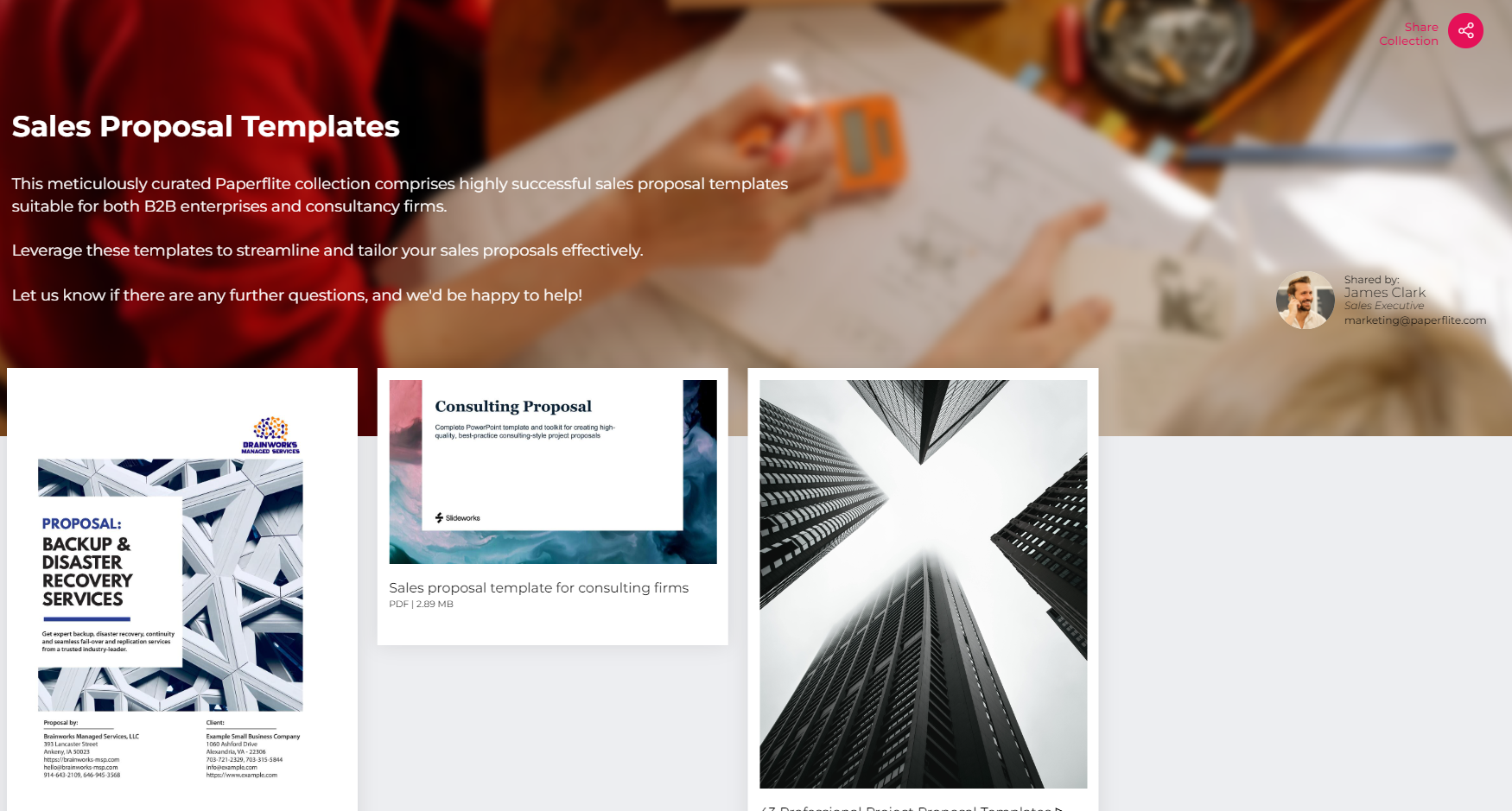
Things to look out for when sending the proposal out:
Check and re-check.
Make sure no information is left out and no punctuation marks are missed. Maintain a checklist of things to review before sending the document out to customers.
The right nudges at the right time
Once you’ve sent the proposal out, get some industry-standard data on the wait time before successive follow-ups to optimise your nudges and maintain a healthy prospect mindshare.
Well-timed follow-ups significantly increase the chances of your proposal being read and discussed with the stakeholders of the deal.
Tracking your prospects’ engagement
A common worry for sales reps worldwide is whether the content they send over to prospects is being consumed - the same goes for sales proposals.
Interactive platforms like cleverstory allow sales reps to track the activity on your sales proposal.
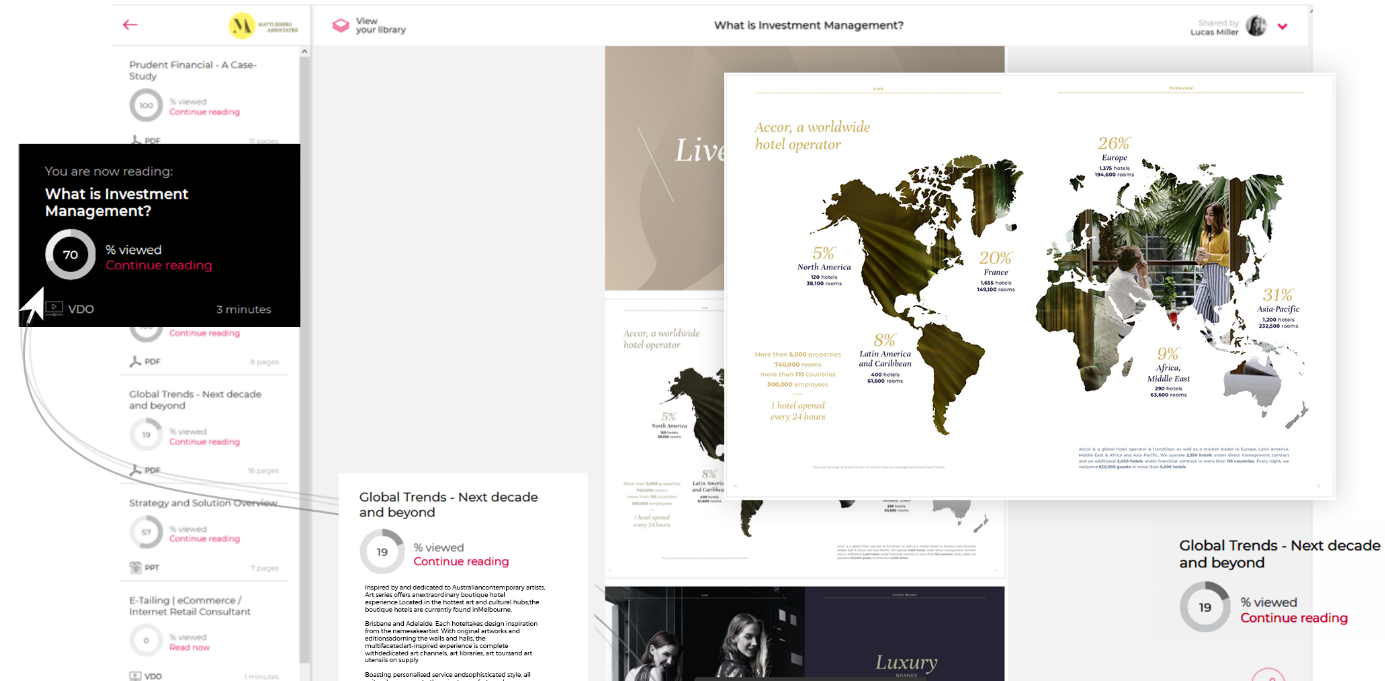
You can gauge the level of engagement by tracking how users interact with the content (like clicks, time spent, and navigation paths). High engagement typically indicates that your offerings interest your prospects.
These analytics can show which of your sales proposal formats resonate the most with buyers, helping to identify trends and preferences in your audience. This can guide future content creation.
Get Actionable Insights That Moves Sales Forward
Summary
Sales proposals tend to make or break deals. Even though they’re widely used, their nuances are endless - and variety even more so.
The ability to create captivating and effective proposals is sure to increase deal win rates.
As steps toward that - this blog walks you through what they are, how they’re used, who writes them, how they’re created, what you’ve got to cover and how you measure the performances of the proposals you send out.
The importance of interactive content in all of these grows more with each day. By leveraging the features provided by these platforms (such as Cleverstory) - creating and iterating on your proposals don’t just become easier, but a lot more effective.
Remember, an effective sales proposal does more than just sell a product or service; it builds a narrative that connects with the buyer's needs and goals. Once this connection is made and established - deals are won and revenue is brought in.
FAQ
How lengthy should a sales proposal be?
A well-crafted proposal should be as long as necessary to convincingly convey the value of the offering and address the client's needs and concerns, but also as concise as possible to maintain the reader's interest and engagement.
Overloading a proposal with unnecessary information can be counterproductive. The key is to strike a balance between thoroughness and succinctness.
Some general guidelines are as follows:
Short proposals: These are typically around 5-10 pages long. They are used for simpler products or services, or when the client has already expressed a strong interest and just needs the specifics.
Medium-length proposals: These often range from 10-25 pages. They are more common for moderately complex products or services, where more detailed information is needed to explain the offering and its benefits.
Long proposals: For highly complex or high-value products and services, especially in sectors like technology, government, or large-scale corporate services, proposals can be 25-50 pages or even longer.
These proposals require detailed technical specifications, thorough explanations of service methodologies, case studies, and often include multiple pricing options and legal terms.
What is the difference between a sales pitch and sales proposal?
A sales pitch is typically a brief written or visual presentation designed to quickly and effectively introduce a product or service. It's usually the first step in the sales process, meant to spark interest and engage potential clients.
A sales proposal is a detailed written document that provides an in-depth description of the product or service, tailored to the specific needs and requests of the potential client. It is often presented after the client has shown interest, typically in response to a request for proposal (RFP).
